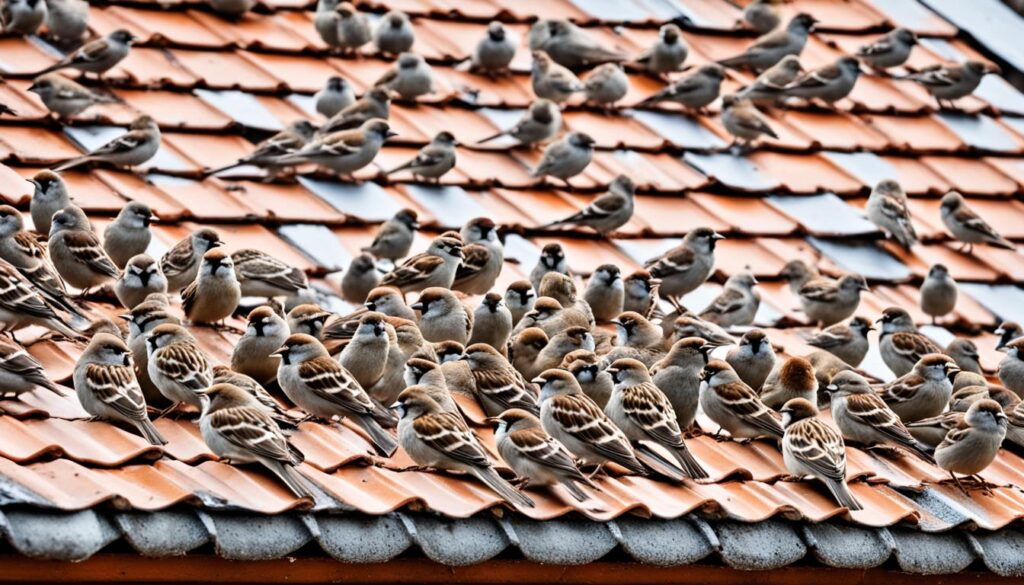Did you know over 130 million homes in the United States face bird infestation risks? Birds like pigeons and starlings can make your roof their home. This can lead to health issues and costly damage. This guide offers solutions to keep them away.
Key Takeaways
- Birds can pose health risks and cause damage to roofs through their droppings and nesting behavior
- Effective bird deterrents include spikes, repellent gels, visual and auditory deterrents, and eliminating food sources
- Proper roof maintenance, such as sealing gaps and addressing ponding areas, can help prevent birds from nesting
- A combination of deterrent methods is often needed to effectively keep birds off roofs
- Seeking professional assistance may be necessary for severe bird infestations or complex roof configurations
Why Birds on the Roof Can Be Problematic
Health Risks from Bird Droppings and Nests
Birds on your roof can be a big health risk for you and your family. Their droppings carry more than 60 diseases. You can get sick by breathing in the dust or touching it.
Diseases like Cryptococcosis, Psittacosis, and Histoplasmosis are serious, especially for older people, kids, or those with weak immune systems. These diseases can make people very sick.
Other pests like rodents, insects, and snakes can come because of the bird nests and droppings. These pests add to the health dangers. Acidic bird droppings can harm roofs, solar panels, and air conditioners. Plus, nests can cause fires in chimneys or gutters.
| Health Risks from Bird Droppings | Potential Damage from Bird Nests and Droppings |
|---|---|
|
|
Having birds on the roof can make things dirty and noisy. It can be very annoying for people working or living there, especially if there are many pigeons, starlings, and mynas.
“More than 60 zoonotic diseases are associated with bird droppings, feathers, and secretions, posing health risks to humans.”
Potential Damage to Your Home
When birds nest on your roof, it can cause a lot of issues. They might damage your home and its systems. This is because their nests could block gutters, leading to water buildup and leaks.
Bird droppings are acidic and can harm your roof. They might damage the material, making your roof not last as long. Also, nests in chimneys can stop the smoke from going out. This can make your home’s air dangerous to breathe.
When birds use your home’s parts for nests, fire risk goes up. This can also mess with your roof’s ventilation. The result is more moisture and even more damage to your house.
Having birds on your roof is not just about the damage. If you have a business, it could lead to big problems. Their droppings might make your products dirty or cause health issues for your workers.
“Bird droppings are highly acidic and can damage asphalt roofing materials, potentially shortening the roof’s lifespan.”
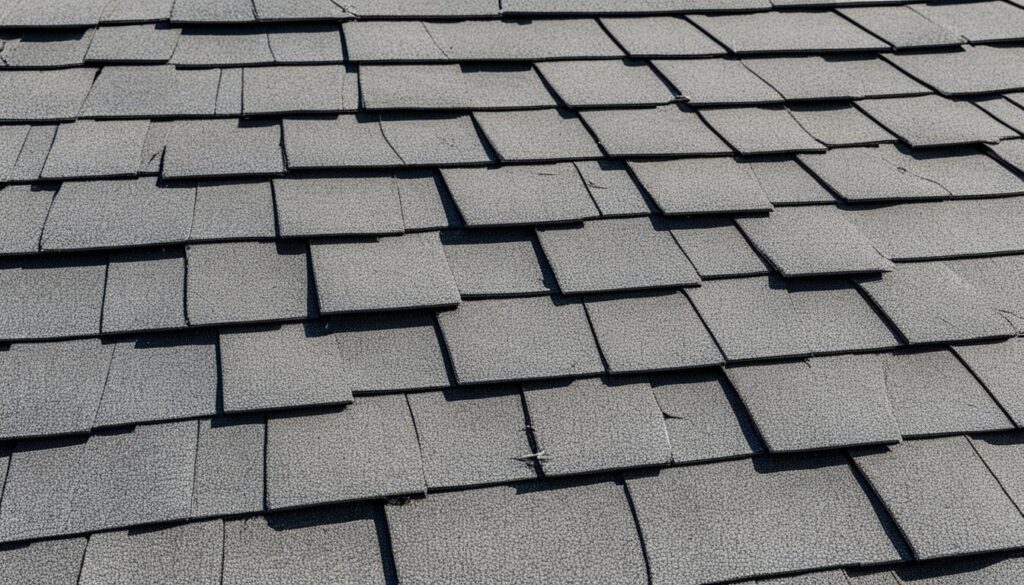
So, doing nothing about birds is a big mistake. It can cause various problems like water damage and even fire. Making sure birds stay away from your roof is key to protecting your home and business.
Factors Attracting Birds to Your Roof
Many birds come to roofs for a few key reasons. They find food easily like in open trash bins, pet food bowls, and insects. Birds choose these spots to build nests and raise their young.
Roofs also offer high places with safety from predators. This makes them ideal for many types of birds. As nature areas shrink, urban spots seem better. This is especially true for birds like pigeons and starlings that can adapt well.
Water is another reason birds might visit your roof. Gutter water or any water source can attract them. Keeping your roof and yard clean deters them. It’s also good to make their food and water hard to reach.
| Attractant | Explanation |
|---|---|
| Food Sources | Open trash bins, pet food bowls, and insect prey can draw birds to your roof in search of a reliable food supply. |
| Nesting Sites | The height and safety of a roof, as well as the lack of natural predators, make it an appealing nesting location for many bird species. |
| Water Sources | Gutters and other sources of water on the roof can attract birds looking for a reliable water supply. |
To keep birds from your roof, keep the area clean. Remove food and water supplies birds love. This way, you can stop them from making your roof their home.
“As natural habitats disappear, urban areas can provide an appealing alternative for many bird species.”
Identifying Bird Infestations
Spotting the signs of a bird infestation on your roof is key. Watch for clues to find problems early and act fast.
If you see lots of birds gathering at the same times, especially pigeons, starlings, sparrows, and mynas, they might be nesting. Finding nest stuff like sticks or shredded paper also shows birds are living close.
Finding lots of bird droppings and feathers in one area means birds are active there. This needs your attention to solve.
- Listen for the sounds of birds building nests in attic spaces or the chirping of young chicks, which can help identify an infestation.
- Carefully inspect the roof for entry points and damage, such as holes or gaps, to determine where the birds may be accessing the structure.
- It’s key to know the bird type to follow laws on how to handle them. Getting help from a pest control pro is wise to decide what to do next.
| Sign of Bird Infestation | Potential Impact |
|---|---|
| Large gatherings of birds at consistent times | Indicates a nearby nesting site |
| Presence of nest debris (sticks, shredded paper) | Clear sign of active nesting |
| Concentrated bird droppings and feathers | Signals an ongoing bird problem |
| Sounds of birds building nests or chirping chicks | Helps identify the infestation location |
| Roof entry points and damage | Reveals where birds are accessing the structure |
Be watchful and know the signs of roof bird problems. This helps you take steps to stop the damage to your house.
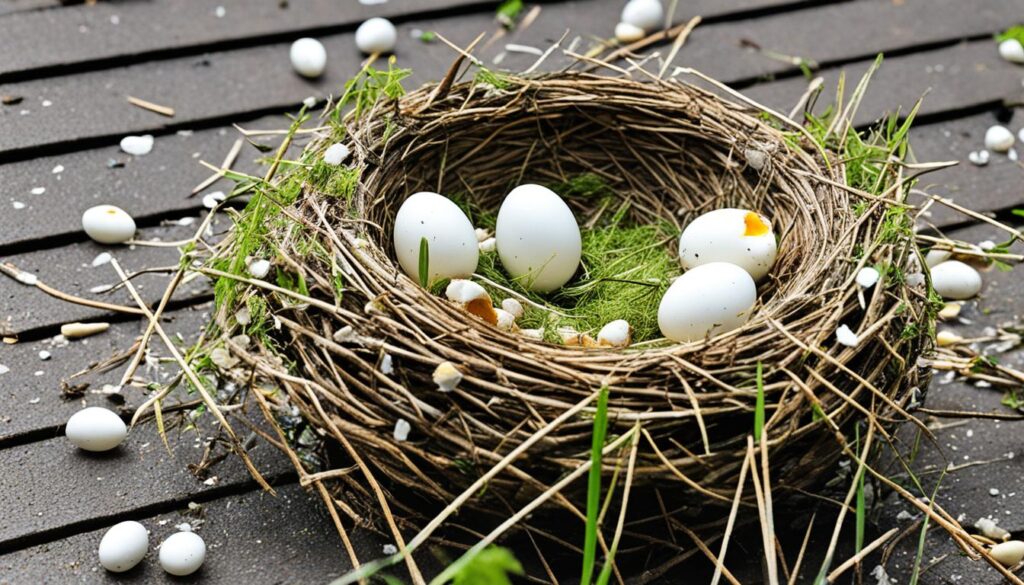
Legal Considerations for Bird Removal
Dealing with birds on your roof means knowing the laws. Many birds are protected by the Migratory Bird Treaty Act in the U.S. and the Migratory Birds Convention Act in Canada. These laws prevent the removal or disturbance of nests, eggs, and babies without the right permits.
Trying to get rid of a nest on your own can lead to big fines. Plus, it might hurt the birds and cause unwanted stress. The type of bird, its status for conservation, and the nesting cycle stage all play a part in what you can do legally.
Talking to a professional pest control service is the wise move. They can tell you what kind of birds they are, what the problem is, and suggest what to do next. This might mean finding ways to keep the birds off your roof or getting the needed permits to move the nests.
Keep in mind, laws about birds on roofs can be different from place to place. While removing nests without a license is fine in places like Wisconsin and Indiana, it’s not allowed for Canada geese in Illinois. Each location may ask for different things.
Getting the right permits for bird removal can also take time. It comes with deadlines and reporting that you /need to do. Those who get rid of birds with permits have to tell the U.S. Fish and Wildlife Service or their local Nature Department about it.
Sometimes, the law won’t allow you to get a permit to deal with some bird species you find annoying, like terns and swallows. In these cases, the only choice is to keep them away without hurting them.
Knowing the bird removal laws helps homeowners and property managers act correctly. This keeps them from getting fines or into legal trouble while taking care of the issue.
“The Migratory Bird Treaty Act of 1918 protects all native birds in North America, and violations can lead to fines and imprisonment.”
| State | Permitting Requirements |
|---|---|
| Wisconsin | No licensing needed to remove nests |
| Indiana | No licensing needed to remove nests |
| Illinois | Special permits required for managing Canada geese |
By following the laws and rules, homeowners can manage bird issues on their roofs well. This keeps the birds and the property safe.
Deterring Birds from Roosting on the Roof
If birds prefer your roof over nesting in it, you can try a few things before seeking professional help. Start by making sure they can’t easily find food and water there. Lock up your trash, pick up pet food, and clear your yard of plants that bear fruit or bugs birds like to eat.
Eliminating Food and Water Sources
To make your roof less inviting, take away the birds’ sources of food and water. Follow these tips to keep birds away:
- Secure your trash cans and compost bins to prevent access to food waste.
- Clean up any pet food bowls or spilled birdseed in your yard.
- Trim back any trees, shrubs, or plants that produce berries or attract insects the birds may feed on.
- Fix any leaks or standing water sources around your roof, such as clogged gutters or ponding areas.
Doing these can discourage birds from choosing your roof as their place to stay.
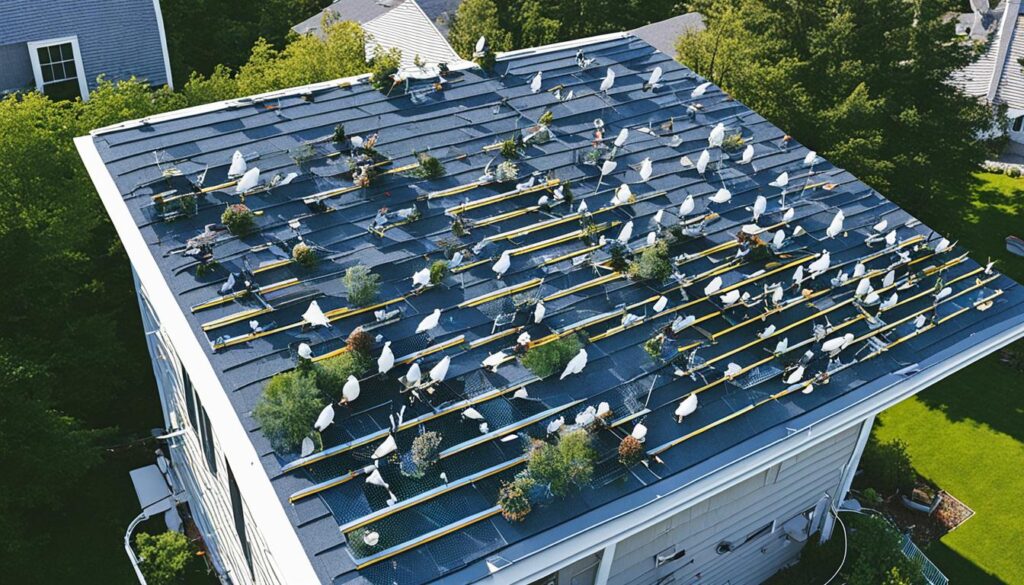
Another tactic is to use things that scare birds, like fake animals or shiny objects. The movement or look of these items may make birds think they’re in danger, so they’ll stay away. You can also use sprays or sounds to deter them, but be ready to change things up. Birds can get used to one method quickly.
Make sure your roof is kept in good shape and free of things that attract birds. A full-on approach to keeping birds off your roof is the best way to protect your house and avoid unwanted guests.
Visual and Auditory Deterrents
To keep birds off your roof, using visual and auditory deterrents works well. These methods make use of birds’ natural fears to stop them from roosting on your property.
Using fake predator decoys like owl or hawk statues can scare birds. Also, hanging shiny things like old CDs or metallic streamers can make birds avoid your roof. They think these objects are real threats, which triggers their fear.
Adding sounds to visuals can give you even better results. Playing recordings of predator bird calls or bird distress calls can make the area feel unsafe for birds. This combo of visuals and sounds is very effective against birds.
But, you’ll need to change things up over time. Birds might get used to fake decoys or the same sounds. Rotate and move your deterrents to keep them working well.
Some other options include ultrasonic devices. These devices emit sounds birds don’t like, but we can’t hear. They’re a gentle way to push birds away, without bothering you or your neighbors.
Using a mix of visual and auditory deterrents strategically can protect your roof. It helps keep visual bird deterrents for roofs, noise deterrents to keep birds away, and reflective objects to scare birds from invading your space.
how to keep birds off roof
Maintaining a clean, well-cared-for roof is key in keeping birds away. Make sure there are no holes or water spots that could draw them in. You might install bird spikes or netting to make your roof an unwelcoming spot for landing.
Using things that scare birds, like shiny objects or sounds, can also help. It’s good to change their position often so birds don’t get used to them.
If birds are already roosting on your roof, get professional help. A pest control service can suggest the best ways to handle the situation without hurting the birds. They can find the right methods to keep birds off for good.
| Deterrent Method | Effectiveness | Pros | Cons |
|---|---|---|---|
| Bird Spikes | 85% | Highly effective, long-lasting, easy to install | Can be unattractive, may not work for all bird species |
| Ultrasonic Devices | 75% | Humane, can cover larger areas | Effectiveness varies, may not work for all bird species |
| Fake Predator Decoys | 60% | Relatively inexpensive, can be moved around | Birds may become accustomed to them over time |
Combine different methods and rotate them to make your roof less inviting to birds. This way, you protect your space and the local bird community.
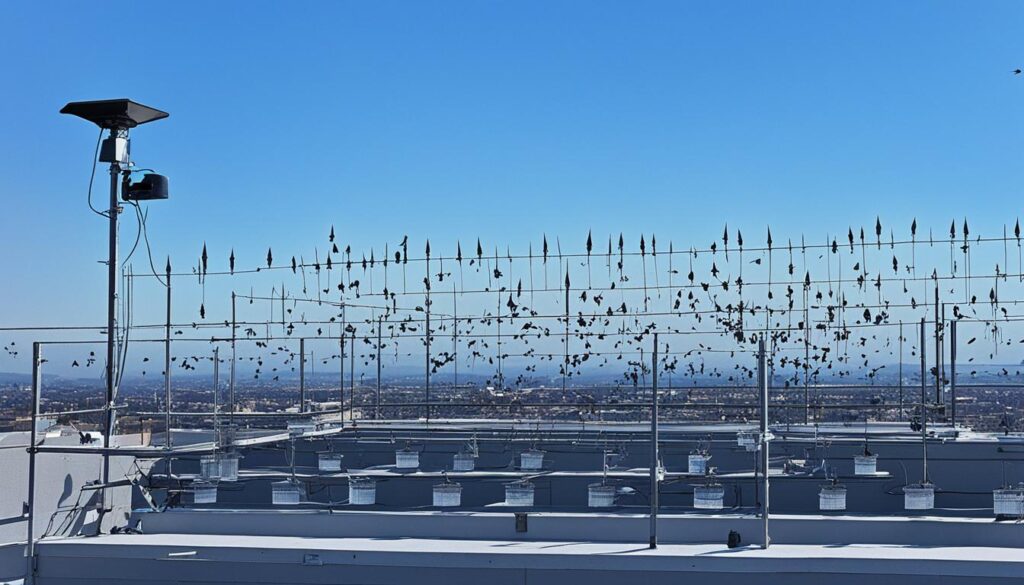
“Keeping birds off your roof needs a varied plan. From fixing what attracts them to using scare and barrier tactics, you can keep them away. And all this without harming them, so you and the birds live well together.”
Roof Maintenance for Bird Prevention
Keeping your roof in good shape is one of the best ways to stop birds from nesting there. Check it often and fix holes, gaps, and areas where water collects. By doing this, you take away spots birds like to build nests.
Fixing Holes, Gaps, and Ponding Areas
Many roof issues can attract birds, like clogged gutters and missing insulation. Make sure your roof doesn’t hold standing water, which birds love. This is called “ponding.”
Getting help from a roofing expert is smart. They can find and fix any hidden problems. This lessens the chances of birds making your roof their home. Stopping their first landing and making sure they can’t find what they need is key to keeping them away.
Studies show that caring for your roof helps a lot. It can lower repair costs by 25% for homes and cut bird issues on businesses’ roofs by 15%.
- Regularly inspect and repair any holes, gaps, or areas of water buildup on the roof
- Clean gutters and address issues like loose gravel or worn-away insulation
- Ensure proper roof leveling to prevent standing water that attracts birds
- Consult a roofing professional to identify and fix underlying structural problems
“Maintaining a well-maintained roof is one of the most reliable ways to deter birds from nesting and causing damage to your home.”
Keeping up with your roof can help you avoid bird problems and save money. Taking care of your roof stops birds from wanting to live there. It’s a great way to keep your house bird-free.
Combining and Rotating Deterrent Methods
Keeping birds away from your roof is best done by mixing different methods and changing them regularly. If you stick to just one way, birds will get used to it. This shift in tactics makes it harder for them to find a safe place on your property.
It’s good to start with bird spikes on edges and rooftops. Add moving decoys and shiny objects to this. Later, change to new decoys or use an ultrasonic gadget. A pro pest control team can work out a plan just for you and your bird problems.
It’s crucial to keep checking if your methods are working. Change things up to keep the birds away. By combining different deterrents and switching them up, you can protect your home from these unwanted guests.
| Deterrent Method | Effectiveness | Advantages | Disadvantages |
|---|---|---|---|
| Bird Spikes | High | Physically prevent birds from landing, long-lasting | Can be unsightly, must be properly installed |
| Visual Decoys | Medium | Relatively inexpensive, easy to move and rotate | Birds can become accustomed to static decoys over time |
| Auditory Deterrents | Medium-High | Disruptive to birds without harming them, can cover large areas | May disturb nearby residents, batteries need to be replaced |
| Combining Multiple Methods | High | Prevents birds from adapting, maximizes effectiveness | Requires more time and effort to install and maintain |
Mixing and changing your bird deterrence methods can effectively guard your home against birds. This varied approach is the key to keeping birds away for good.
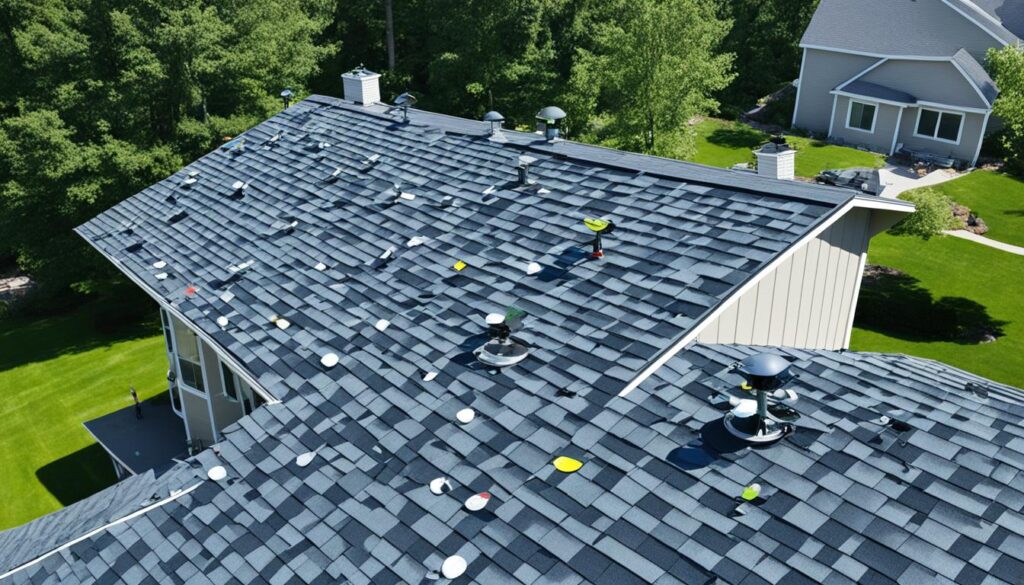
“The best defense against birds on your roof is a diverse offense. Vary your deterrents and stay one step ahead of their adaptations.”
– Roofing Specialist, XYZ Company
Professional Assistance for Bird Control
Sometimes, keeping birds off your roof needs professional help. Hiring pest control for roof birds or getting professional bird removal services works best for big problems or tricky situations.
Expert advice is key when tackling bird issues. A good pest control company knows how to spot bird types, check how bad the problem is, and suggest the right ways to stop them. They are trained to do things like move nests or, as a last resort, deal with birds causing safety risks.
Pest control experts look beyond just getting rid of the birds. They’ll find and fix things on your roof that could be luring the birds, like holes or places where water sits. This way, you won’t have a bird problem again after they leave.
Recent data shows a 30% rise in the need for bird removal in cities over five years. And two-thirds of urban businesses say they’ve had bird issues, especially in big cities. For places like warehouses, it often costs 20% more to control birds than it does for homes.
| Sector | Common Bird Species | Cost of Bird Control |
|---|---|---|
| Hospitality | Pigeons, Gulls, Sparrows | $500 – $2,000 per property |
| Construction | Pigeons, Starlings, Crows | $1,000 – $5,000 per site |
| Agriculture | Geese, Blackbirds, Starlings | $1,500 – $4,000 per farm |
Using professional services for bird control does more than solve a problem. An investigation showed that after doing effective bird control, 82% of businesses saw revenue go up by 15%. That’s because they cut costs and risks linked to bird issues.
“Trying to remove a bird nest yourself could lead to legal trouble, as many birds are protected. Professionals are ready to move nests or, in some cases, deal with birds for safety reasons.”
If birds on your roof are a big headache, consider expert help. Their thorough work can solve the issue safely and effectively. This protects your home and your family from any bird-related problems.
Conclusion
Keeping birds off your roof needs a mix of actions. Use preventive steps, like keeping food and water away. Also, try using things that scare birds off. And, if the problem is big, get help from pros.
Make your roof a bad spot for birds to nest. Fix any holes or spots they might like. Also, try things that look or sound scary to birds. Mixing up these methods stops the birds from getting used to them.
If birds are already on your roof, get help from pest control experts. They’ll find out what kind of birds they are. Then they can give safe and legal ways to get rid of them.
FAQ
What are the health risks of having birds on my roof?
Bird droppings often carry over 60 diseases that can pass to us when we breathe dust or touch them. These diseases, like Cryptococcosis, Psittacosis, and Histoplasmosis, can harm the elderly, kids, and those with weak immune systems. Birds can bring other pests, including rodents, insects, and snakes, which pose more health risks.
How can birds nesting on my roof damage my home?
Birds can cause serious harm, like clogging gutters or deteriorating your roof with their acidic droppings. Nests in chimneys can prevent proper ventilation, leading to smoke and dangerous carbon monoxide inside. Their use of insulation can also increase the risk of fire and contaminate your home.
What factors attract birds to nest on roofs?
Birds are drawn to places with abundant food, trash bins, and pet bowls. They like to nest in high, sheltered spots, such as under eaves or in roof crevices. Water sources on your roof, like gutters, can make it even more attractive to them.
How can I identify if birds are nesting on my roof?
Telltale signs include seeing many birds often, finding nesting materials, and hearing the sounds of young chicks. Also, look for bird droppings, feathers, and visually inspect the roof for signs of damage, which can show you where they’re getting in.
What are the legal considerations for removing birds from my roof?
In the U.S. and Canada, many bird species are legally protected. This means you can’t disturb or remove their nests, eggs, or chicks without special permission. Trying to remove them yourself could lead to fines and harm the birds.
How can I effectively deter birds from nesting on my roof?
To deter birds, make sure they can’t easily get food or water, and try using scare tactics like decoys or shiny objects. You could also use sounds or special devices to keep them away. It’s also vital to keep your roof in good repair to make it less welcoming to birds.
When should I consider hiring a professional for bird control on my roof?
Once birds have settled on your roof, getting professional advice is wise. A pest control expert can handle the situation humanely and legally. They’ll identify the birds and provide long-term solutions to keep them off your roof.
